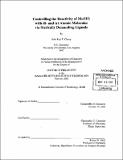Controlling the reactivity of Mo(III) with di- and tri-atomic molecules via sterically demanding ligands
Author(s)
Cherry, John-Paul F. (John-Paul Francis), 1971-
DownloadFull printable version (12.39Mb)
Other Contributors
Massachusetts Institute of Technology. Dept. of Chemistry.
Advisor
Christopher C. Cummins.
Terms of use
Metadata
Show full item recordAbstract
Chapter 1. Molybdenum Dinitrogen Chemistry: Formation and Reactivity of (Ar[tBu]N)3MoN2- A collection of (Ar[tBu]N)3MoN2- compounds, supported with Na+, K+, Mg2+ and Ca2+ have been prepared through a variety of synthetic routes. In several experiments, N2 was replaced with other small molecules to produce such complexes as (Ar[tBu]N)3MoCS2- and (Ar[tBu]N)3MoCO-. In most of the experiments examined, N2 was maintained and functionalized as a ligand to create a variety of complexes with the formula (Ar[tBu]N)3MoN2X, where X = Me, Ti(NMe2)3, ZrCp2(Me), GeMe3, SnMe3, AlMe2, ZnMe(THF)2, P(NMe2)2. The functionalized Np with these metal or main-group substituents was shown to have a rather robust bond into which CO2 insertion was not possible. However, the reactivity derived from within a series of carboxydiazenido complexes, (Ar[tBu]N)3MoN2CO2R was strikingly different. The molecule fell apart upon deprotecting the CO2 fragment by removing an alkyl group, unless stabilized with the trimethylsilyl group. Overall, the knowledge gained from this assortment of compounds may be valuable for future dinitrogen chemistry of (Ar[tBu]N)3Mo or other dinitrogen complexes in general. Chapter 2. A di-Molybdenum gu-N Compound as a Reactive Precursor and a Gateway into N2 Chemistry of (Ar['Pr]N)3Mo and (AdO)3Mo ((Ar['Pr]N)3Mo )2(1 -N) was investigated electrochemically as well as synthetically. The anion and cation were both synthesized and investigated as [Na(THF)x][ ( (Ar['Pr]N)3Mo 12(I-N )] and [( (Ar['Pr]N)3Mo 12(-N) ][OTf], respectively. The triflate salt was isolated as a stable complex whereas the sodium salt was characterized in situ. (cont.) [((Ar['Pr]N)3Mo)2(,-N)][OTf] was reacted with pyridine-N-oxide to cleave a Mo-N bond and form [(Ar['Pr]N)3MoO][OTf] and (Ar['Pr]N)3MoN. [Na(THF)x][( (Ar['Pr]N)3Mo )2(-N)] was generated in situ and X (where X = N2 or CO) was introduced to form [Na(THF)x][XMo(N['Pr]Ar)3] and (Ar['Pr]N)3MoN. A variety of '5N2 experiments were conducted and examined by 15N NMR. (Ar[iPr]N)3MoN2Me and (Ar[i'Pr]N)3MoN2CO2Me were synthesized directly from [Na(THF)][N2Mo(N[Pr]Ar)3]. The methyldiazenido complex was found to react with (Ar['Pr]N)3V and to transfer the N-CH3 unit to form the methylimido complex, (Ar[iPr]N)3VNMe and (Ar['Pr]N)3MoN. Similarly, an equivalent of the carboxymethyldiazenido complex transferred the NCO2Me unit to two equivalents of (Ar['Pr]N)3V to form (Ar['Pr]N)3MoN and ((Ar['Pr]N)3V )2(1 , 2-NCO2Me). The methyldiazenido complex readily formed the dimethyldiazenido cation, [(Ar['Pr]N)3MoN2Me2] [OTf], when subjected to, treatment with methyl triflate. This complex can be reduced (Cp2Co) or attacked by a nucleophile (LiC6H5) to cleave its N-N bond and produce organic compounds such as dimethylamine and N,N-dimethylaniline, incorporating the Np-atom. The methyldiazenido and carboxymethyldiazenido complexes supported by -OAd ligands, (AdO)3MoN2Me and (AdO)3MoN2CO2Me, were obtained from their respective N-iso-propylanilide complexes via alcoholysis. Also, [(AdO)3MoN2Me2][OTf] was synthesized by the addition of methyl triflate to (AdO)3MoN2Me. The alkoxides share a similar reactivity to their N-iso-propylanilide analogs with respect to reductive cleavage of the N-N bond and formation of (AdO)3MoN ...
Description
Thesis (Ph.D.)--Massachusetts Institute of Technology, Dept. of Chemistry, 2002. Vita. Includes bibliographical references.
Date issued
2002Department
Massachusetts Institute of Technology. Department of ChemistryPublisher
Massachusetts Institute of Technology
Keywords
Chemistry.